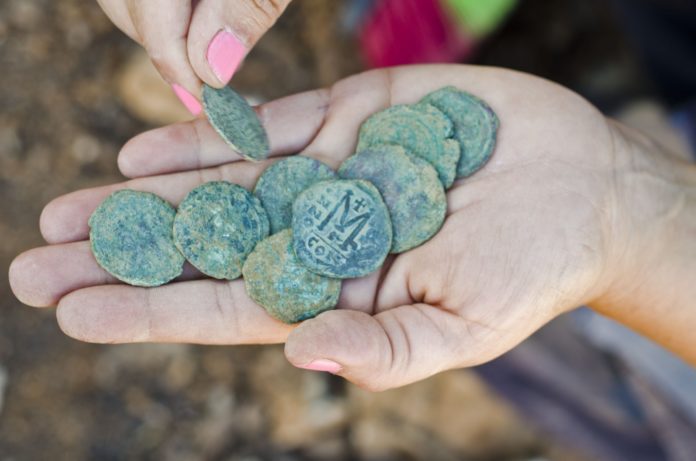Byzantine Coin Cache Discovered in Excavations Near Jerusalem
Israeli archaeologists announced the discovery of a 1,400-year-old cache of coins, discovered during excavations for the widening of the Tel Aviv- Jerusalem highway.
The cache, constituting nine bronze coins dating from the Byzantine Period (324-638 CE), were discovered alongside a large two-story structure and an adjacent wine press, also exposed during the excavations.
“The [coins were] found among a group of large stones that had collapsed alongside the building,” said Annette Landes-Nagar, director of the excavation on behalf of the Israel Antiquities Authority.
The coins bear the images of three important Byzantine emperors, Justinian (483-565 AD), Maurice (539-602 CE), and Phocas (547-610 CE). They were struck at mints in Constantinople (Istanbul), Antioch, and Nicomedia, all located in modern-day Turkey.
The coins feature an image of the emperor wearing military garb and carrying crosses, while the reverse indicates the coin’s denomination and are inscribed with the letter M.
“It seems that during a time of danger the owner of the hoard placed the coins in a cloth purse that he concealed inside a hidden niche in the wall,” said Landes-Nagar. “He probably hoped to go back and collect it, but today we know that he was unable to do so.”
She added that the location and the fact the cache was hidden indicates that it can be traced to the Sassanid Persian invasion in 614 CE. This invasion was one of the factors that culminated in the end of Byzantine rule in the Land of Israel. Fearing an invasion and imminent danger, residents of the site buried their money against the wall, hoping to return home at the end of the disturbances, which did not happen. The site was abandoned and destroyed, and ultimately covered over and incorporated into the agricultural terraces of today’s region.
The building and the wine press beside it belong to a larger site, unearthed about a year ago, on the other side of the highway. That excavation unearthed a Byzantine church, several settlements and way stations, some of which were near flowing springs, developed next to the road that was used by Christian pilgrims on their way to Jerusalem.
Recent investigations suggest the site actually represents a settlement named Einbikumakube, situated alongside the main road leading from the coastal plain to Jerusalem. The name would have been preserved by the neighboring Arab village Beit Naqquba, near Abu Ghosh.






